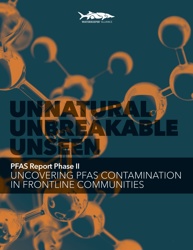New Analysis Finds PFAS In 98% Of Tested U.S. Waterways Across 19 States

A new report released today by Waterkeeper Alliance, in partnership with local Waterkeeper groups and the Hispanic Access Foundation, reveals that toxic per- and polyfluoroalkyl substances (PFAS) have contaminated 98% of tested U.S. waters, with elevated levels found at 95% of sampled sites downstream from wastewater treatment plants (WWTPs) and 80% downstream from biosolids land application sites.
Building on the 2022 Phase I report—which revealed PFAS contamination in 83% of tested U.S. rivers, lakes, and streams—this second of a multi-phase monitoring initiative focused on sites downstream from WWTPs and permitted biosolids application fields, particularly in disproportionately impacted communities across 19 states. Using PFASsive™ passive samplers, developed by SiREM, these devices were deployed upstream and downstream of 22 WWTPs and 10 biosolids application fields, capturing PFAS levels over at least 20 days—providing more accurate insight than traditional “grab” sampling.
“There is no denying that PFAS contamination is a national crisis. Our latest sampling confirms that it’s widespread and persistent, threatening waterways and public health across the country,” said Marc Yaggi, CEO of Waterkeeper Alliance. “Local Waterkeepers and partners bring deep local knowledge and dedication to this ongoing effort, helping to fill critical data gaps, driving policy and solutions.”
“PFAS can contaminate our water, soil, air, and evidence suggests that it is linked to several diseases and health risks,” added Vanessa Muñoz, Waterways Program Manager, Hispanic Access Foundation. “But what is often overlooked is who is being exposed to it and why, and unfortunately Latino and other communities of color are disproportionately faced to bear the burden.”
Key Findings:
- Widespread Contamination: PFAS were found at 98% of sampling sites across 19 states, both upstream and downstream of WWTPs and biosolids application fields.
- Downstream Increases: 95% of downstream WWTP sampling sites and 80% of downstream biosolids sampling sites had higher concentrations of multiple types of PFAS compared to the upstream sampling sites.
- Most Detected PFAS:
- WWTPs: PFOA, PFHxA, PFBS, PFPeA, PFHpA, PFHxS, PFOS.
- Biosolids: PFBA, PFBS, PFPeA, PFHxA, PFHpA.
- Health Risks:
- Total PFAS exceeded the Environmental Working Group’s 1 parts per trillion (ppt) human health-based criteria at all WWTP and 90% of biosolids sites.
- Surpassed federal drinking water thresholds for PFOA and PFOS at multiple sites, with some exceeding 10 ppt.
- Unregulated PFAS: Unregulated chemicals like PFPeA and PFHxA often contributed to PFAS increases downstream.
- Downstream Spikes:
- WWTPs: Total PFAS increased downstream from 17 sites, with one site spiking nearly 3,000% to 228.29 ppt.
- Biosolids: Total PFAS increased downstream from six sites, with one site spiking more than 5,100% to 106.51 ppt.
This report comes just months after the U.S. Environmental Protection Agency (EPA) announced plans to weaken national drinking water standards for PFAS. Despite knowing that PFAS contamination affects the drinking water of approximately 100 million people in the United States, Administrator Lee Zeldin is considering rolling back regulations for several harmful compounds—including PFHxS, PFNA, and GenX—and delaying enforcement of new rules for PFOA and PFOS, two of the most dangerous PFAS. Further compounding the issue is the lack of federal limits for PFAS in biosolids even though the agency has been aware of its presence in the product since at least 2003. In 2023, EPA estimated that 60% of biosolids were land-applied for agriculture, reclamation, or other uses—with 31% applied to U.S. agricultural land.
Waterkeeper Alliance urges EPA and lawmakers at all levels to:
- Establish and enforce federal standards for PFAS in drinking water and surface water discharges under the Safe Drinking Water Act and the Clean Water Act;
- Prohibit the land application of PFAS-contaminated biosolids;
- Implement class-based regulation of PFAS instead of individual compounds to help address the health risks posed by exposure to multiple PFAS chemicals, prevent harmful substitutions, and streamline monitoring, treatment, and enforcement efforts; and
- Prioritize funding for PFAS monitoring and the deployment of treatment technologies to protect all communities, especially those disproportionately impacted by ‘forever chemicals’ and other forms of pollution.
“Currently, there is little accountability for PFAS entering our environment and water through poorly regulated pathways,” continued Yaggi. “American communities are exposed daily, often unknowingly, and many face serious, disproportionate health risks. The tools to address this crisis exist, but the political will is lacking. We cannot afford more watered-down regulations and loopholes for industrial source polluters. The science is clear: EPA and lawmakers must act decisively, and with urgency, in the public’s interest.”
Read the full report here.
Source: Waterkeeper Alliance
